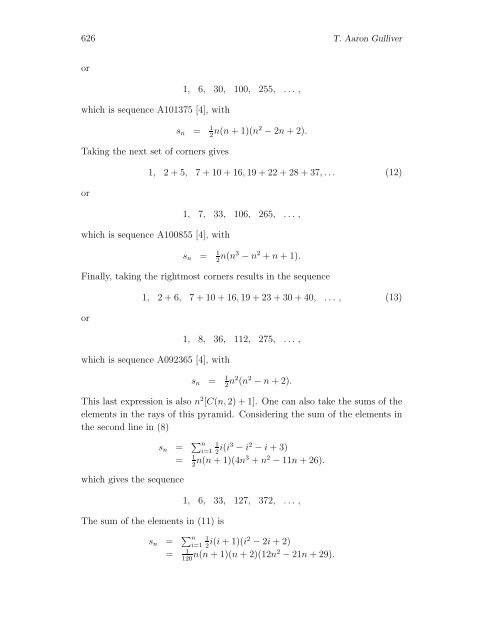Sequences from Pentagonal Pyramids of Integers - HIKARI Ltd
Sequences from Pentagonal Pyramids of Integers - HIKARI Ltd
Sequences from Pentagonal Pyramids of Integers - HIKARI Ltd
Create successful ePaper yourself
Turn your PDF publications into a flip-book with our unique Google optimized e-Paper software.
626 T. Aaron Gulliver<br />
or<br />
which is sequence A101375 [4], with<br />
Taking the next set <strong>of</strong> corners gives<br />
or<br />
1, 6, 30, 100, 255, ... ,<br />
s n = 1 2 n(n + 1)(n2 − 2n +2).<br />
1, 2+5, 7 + 10 + 16, 19 + 22 + 28 + 37,... (12)<br />
which is sequence A100855 [4], with<br />
1, 7, 33, 106, 265, ... ,<br />
s n = 1 2 n(n3 − n 2 + n +1).<br />
Finally, taking the rightmost corners results in the sequence<br />
or<br />
1, 2+6, 7 + 10 + 16, 19 + 23 + 30 + 40, ... , (13)<br />
which is sequence A092365 [4], with<br />
1, 8, 36, 112, 275, ... ,<br />
s n = 1 2 n2 (n 2 − n +2).<br />
This last expression is also n 2 [C(n, 2) + 1]. One can also take the sums <strong>of</strong> the<br />
elements in the rays <strong>of</strong> this pyramid. Considering the sum <strong>of</strong> the elements in<br />
the second line in (8)<br />
which gives the sequence<br />
The sum <strong>of</strong> the elements in (11) is<br />
s n = ∑ n 1<br />
i=1 2 i(i3 − i 2 − i +3)<br />
= 1n(n + 2 1)(4n3 + n 2 − 11n + 26).<br />
1, 6, 33, 127, 372, ... ,<br />
s n = ∑ n 1<br />
i=1<br />
i(i + 2 1)(i2 − 2i +2)<br />
= 1 n(n + 1)(n + 120 2)(12n2 − 21n + 29).
















